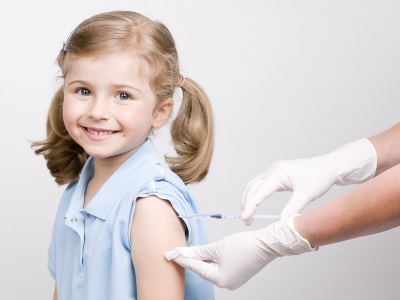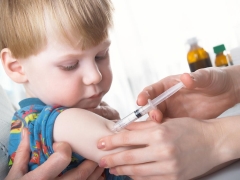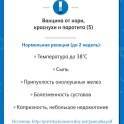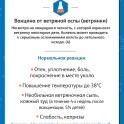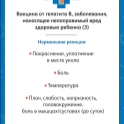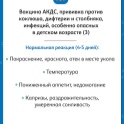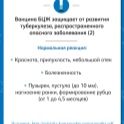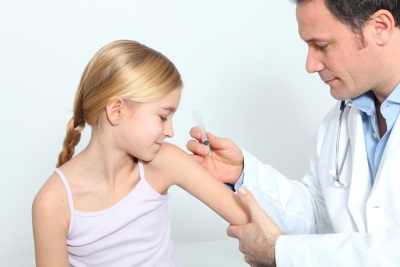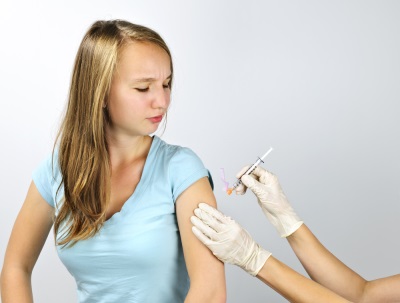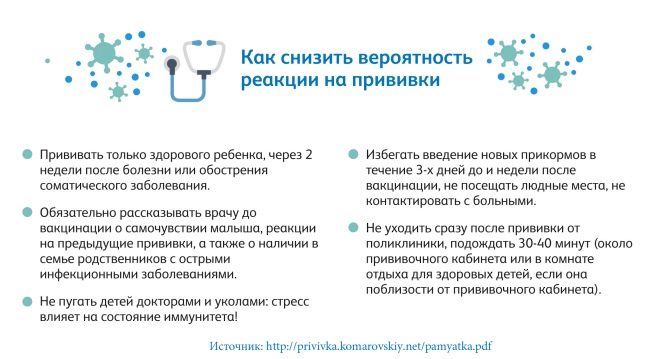Vaccination schedule for children in Russia
In each country, at the state level, a calendar is established according to which children are vaccinated. Let's look at the vaccination schedule in Russia, especially since it has changed a little since 2014.
Contraindications
Before you learn about the timing of vaccination, parents should be familiar with the factors that are the reasons not to vaccinate the baby at all or for a certain period.
- An obstacle to the introduction of any vaccine is an adverse reaction to the administration of this drug in the past (there was a strong adverse reaction or complications appeared).
- Also, no vaccines can be administered for immunodeficiencies, malignant tumors and reduced function of the immune system under the influence of drugs.
- Contraindications for the introduction of BCG are low birth weight (less than 2 kg).
- DTP vaccination is not given for progressive diseases of the nervous system and the presence of a convulsive syndrome in the past.
- Measles, mumps, and rubella vaccines should not be given for allergies to aminoglycosides.
- If the child is allergic to egg white, he should not be given anti-rubella, measles, flu, and mumps medications.
- It is not possible to vaccinate against hepatitis B if you are allergic to baker's yeast.

Table
What kind of infection is the vaccine | Terms of vaccination | Terms of revaccination | Special features |
Hepatitis B | 1 - in the first 24 hours after birth; 2 - in 1 month; 3 - in 6 months | - | If the child is in a risk group, the third vaccination is postponed to the age of 2 months, and the fourth vaccination is performed at 1 year. |
Tuberculosis | 1 - for 3-7 days of life | 1 - in 6-7 years; 2 - at the age of 14 | Primary vaccination is carried out with BCG-M, and the BCG vaccine is administered with an increased risk of tuberculosis for the child (living in a region with high morbidity rates, the presence of tuberculosis in close relatives). |
Diphtheria | 1 - in 3 months; 2 - in 4.5 months; 3 - in 6 months | 1 - in 18 months; 2 - in 6-7 years; 3 - at the age of 14 | Starting from the second revaccination, a vaccine with a smaller amount of antigens is used. |
Whooping cough | 1 - in 3 months; 2 - in 4.5 months; 3 - in 6 months | 1 - at 18 months | Vaccination is carried out with a comprehensive vaccine that also protects against tetanus and diphtheria. |
Tetanus | 1 - in 3 months; 2 - in 4.5 months; 3 - in 6 months | 1 - in 18 months; 2 - in 6-7 years; 3 - at the age of 14 | Starting from the second revaccination, a vaccine with a smaller amount of antigens is used. |
Pneumococcal infection | 1 - in 2 months; 2 - in 4.5 months; | 1 - in 15 months | |
Hemophilic infection | 1 - in 3 months; 2 - in 4.5 months; 3 - in 6 months | 1 - in 18 months; | Children at risk are vaccinated. |
Polio | 1 - in 3 months; 2 - in 4.5 months; 3 - in 6 months | 1 - in 18 months; 2 - in 20 months; 3 - at the age of 14 | For the first two vaccinations, an inactivated version of the vaccine is used, then children are given a live vaccine. |
Rubella | 1 - in 12 months | 1 - at 6 years | A comprehensive vaccine is also used for vaccination, which also protects against measles and mumps. |
Measles | 1 - in 12 months | 1 - at 6 years | A comprehensive vaccine is also used for vaccination, which also protects against rubella and parotitis. |
Parotitis | 1 - in 12 months | 1 - at 6 years | A comprehensive vaccine is also used for vaccination, which also protects against measles and rubella. |
Flu | From 6 months | - | Vaccination is carried out annually. |
In addition, children are vaccinated against rubella at the age of 13 and measles in 15-17 years old, if the children have not been vaccinated against these infections, have not had any disease, or have received only the first vaccine.
Types of vaccination
The vaccine can be administered to the child in the following ways:
- Intramuscularly. This is one of the most common ways to ensure a fairly rapid resorption of the drug. Immunity after such an injection is formed quickly, and the risk of allergies is less, because the muscles are well supplied with blood and removed from the skin. Children under two years of intramuscular vaccination are carried out in the thigh. The injection is carried out in the anterolateral region, directing the needle perpendicular to the skin. For babies older than two years, the vaccine is injected into the deltoid muscle. Introduction to the gluteus muscle is not practiced because of the small length of the needle (the injection is obtained subcutaneously).
- Subcutaneously. In this way, a large number of drugs are administered, for example, a rubella, mumps and measles vaccine. Its differences are more accurate dosage than with the oral and intradermal method, as well as a lower absorption rate and the formation of immunity, which is valuable in the presence of problems with blood clotting. In this case, vaccines against rabies and hepatitis B can not be administered under the skin. The injection sites for subcutaneous vaccination are areas of the shoulder, the front of the thigh, or the area under the scapula.
- Intracutaneously. An example of the use of this method of vaccination is the introduction of BCG. A syringe with a thin needle is used for the injection. The injection is performed in the shoulder area. At the same time for the prevention of complications it is important not to introduce the drug under the skin.
- Through the mouth. This method of administering the drug is also called oral. An example of vaccination with this method is polio vaccination as an oral preparation. The technique is very simple - the right amount of the drug is dropped into the child’s mouth.
- Into the nose. Vaccines are presented in this way, presented in the form of an aqueous solution, cream or ointment (for example, against rubella or flu). The minus of the method is the complexity of the dosage, as part of the drug enters the gastrointestinal tract.

Revaccination
Revaccination is referred to as manipulation, ensuring the maintenance of immunity to diseases to which the child was previously vaccinated. The child is once again injected with the drug so that the repeated production of antibodies will increase protection against a specific disease.
Depending on the vaccination, revaccinations can be performed 1-7 times, and sometimes not. For example, revaccinations against hepatitis B are not performed, and against tuberculosis are carried out only with negative results of Mantoux. Against diseases such as rubella, whooping cough, parotitis, pneumococcal infection and measles, revaccination is carried out only once, but maintaining immunity against tetanus and diphtheria requires regular revaccination until the end of life.
Vaccination schedule by age
Up to 1 year
The very first vaccine that a newborn baby encounters while still in the maternity hospital is a vaccine against hepatitis B. It is performed on the first day of the postpartum period. From the third to the seventh day of life, the baby is given BCG. The injection is made in the maternity hospital intracutaneously in the shoulder of the baby. Hepatitis B vaccination is repeated a month.
A three-month baby is waiting for several vaccines. At this age, vaccinated against polio, pneumococcal infection, whooping cough, tetanus and diphtheria. If an infant is at risk, he also receives a vaccine for a hemophilic infection. The same list of vaccinations is characteristic for the age of 4.5 and 6 months, except for the pneumococcal vaccine, which is vaccinated only twice (in 3 months and in 4.5 months).In addition, at 6 months of age, for the third time vaccinated against hepatitis B.
Up to 3 years
One year old baby is sent for vaccination against parotitis, rubella, and measles. The vaccine that protects against these infections is complex, so there will be only one shot. Also, at 1 year, children who are at risk for this disease are vaccinated against hepatitis B.
At the age of 15 months, the child will experience revaccination from pneumococcal infection. In 1.5 years begins revaccination from tetanus, polio, diphtheria and whooping cough. Another revaccination against polio is carried out at the age of twenty months.
Up to 7 years
At the age of 6, revaccination for mumps, measles and rubella is waiting for a child. A seven-year-old child is vaccinated with BCG again, if there are indications for this. Also at this age, the child receives the ADS vaccine, which supports his immunity against tetanus and diphtheria.
Under 14 years old
At the age of 13, children are vaccinated selectively - if the child has not been vaccinated before or there is no information about previous vaccinations. Girls are additionally given rubella vaccine.
Under 18 years old
At the age of 14, the time comes for another revaccination against infectious diseases such as tetanus, polio, tuberculosis and diphtheria. Also at this time, you can be vaccinated against measles and hepatitis B, if previously no vaccinations against these viral infections have been carried out.
Preparation for vaccination
Before you vaccinate a child, you need to determine his state of health. This will help inspection specialists (often required to show the baby to a neurologist or allergist), as well as urine and blood tests. Before vaccination, it is important not to change the diet of the baby and not to include new products in it.
Also, parents are advised to purchase antipyretic drugs in advance, as many children have a temperature reaction to the vaccine. If there is a risk of an allergic reaction, a few days before vaccination and a few days after the injection it is worth giving the child an antihistamine. When vaccinating children up to one year in the clinic, it is worth taking a clean diaper with you, as well as a toy.
Tips
Vaccination is actively promoted and recommended by WHO and doctors, however, parents' consent is also needed for vaccinations. There have always been parents who refused to give vaccines to their children for certain reasons. Frequent failure has led to an increase in the incidence of infections such as whooping cough and diphtheria. In addition, due to refusal of vaccinations, there is a high risk of polio outbreaks and other dangerous infections. Of course, vaccinations cannot be attributed to completely safe procedures, but the safety of vaccinations is much higher than the disease that vaccinations prevent.
Parents are advised not to interrupt the vaccination schedule. This is especially important for vaccination against diphtheria. Only revaccination can refuse or skip. If you are not sure if a vaccine will damage your child, contact an immunologist who, if there are temporary contraindications (for example, diathesis), will develop an individual vaccination plan for your baby.
